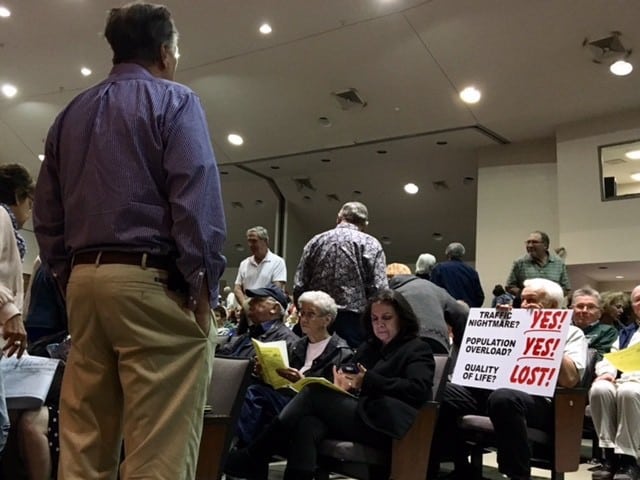
LAKEWOOD – The state Department of Environmental Protection has rejected an application from GDMS Holdings that would allow 1,872 homes to be built on the Eagle Ridge Golf Course, a 27-hole public golf club built in 1999.

The applicant had applied for a Coastal Area Facility Review Act (CAFRA) Individual Permit and a Freshwater Wetlands General Permit to construct 390 duplexes, 52 triplexes, 936 basement apartments and five community centers. It was opposed by residents who live at the neighboring Fairways at Lake Ridge, a 55-and-over development adjacent to the golf course. Officials from several local municipalities opposed it as well.
A public hearing was held on May 9 at Jackson Memorial High School, where many residents of the Fairways community showed up to voice their opposition to the proposed development. Concerns about traffic, overpopulation, endangering wildlife and obstructing their backyard view of the golf course were common themes during the meeting, which packed the high school’s auditorium to near capacity.

A denial letter dated Aug. 3, from the New Jersey Department of Environmental Protection (NJDEP) Division of Land Use Regulation was sent to Mordechai Sternstein of GDMS Holdings of Lakewood, citing various missing, incorrect and incomplete information within his initial application. That application was received by the NJDEP on February 15.
“The DEP’s rejection of the CAFRA and Wetlands permits for 1,800 homes at Eagle Ridge is a victory for the environment. Instead of siding with developers, DEP decided to stand up for sound planning, clean water, and environmental protection. With this proposal, GDMS Holdings wanted to build massive suburban development on top of wetlands and a landfill. This project would be an environmental disaster because the residents would experience flooding and pollution runoff into the Barnegat Bay,” said Jeff Tittel, Director of the New Jersey Sierra Club.
Traffic congestion, endangering the state threatened red-headed woodpecker and inaccurate stormwater maps were primary findings outlined in the letter. The DEP also felt that extending sewer lines west from the existing New Jersey American Water pump station along Cross Street would encourage future development of the land and endanger critical wildlife habitats.

Another major issue seemed to be tree preservation. Coastal Fringe Planning Areas require 70 percent tree preservation in forested areas and 5 percent tree preservation or tree planting in forested areas. The applicant had attempted to set aside a parcel of land in Manchester Township known as Block 79, Lot 41.01 to preserve trees, which is 10 miles from the proposed development site and inside the Pinelands National Reserve. The problem is, that patch of land is beyond the regulated CAFRA jurisdictional area and was found to have no “ecological nexus” to the project site, so the applicant can’t use it to satisfy that portion of the application.
The applicant also proposed $776,755 for roadway and traffic upgrades to promote the flow of traffic, but the New Jersey Department of Transportation identified a missing traffic study at the intersection of Route 9 and Prospect Street, as well as an intersection at Chestnut Street and New Hampshire Avenue that would no longer function without a traffic signal.
Although an agent of GDMS Holdings did submit an updated application on July 21 with a revised project plan, there was no documentation showing that the updates were sent to the municipal clerk or to individuals that were determined to be affected by the revised application. Because of that, the NJDEP has not evaluated that revised application.
The denial letter states that the revised design reduced the number of residential units, a commercial building and parking, reconfigured proposed roadways and site access, and provided additional stormwater management facilities. A revised Stormwater Management report and Traffic Impact Study were also included.







